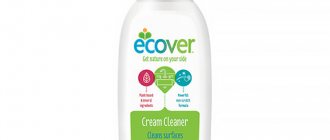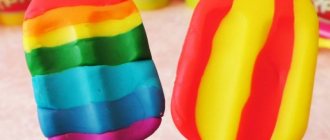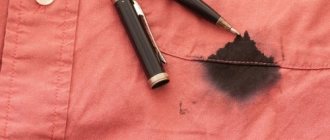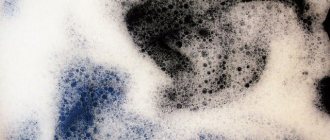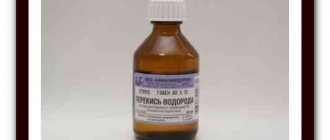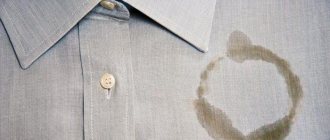What to do if there is hair dye left on your clothes
Fresh stains are much easier to remove. Therefore, it is better to immediately inspect things for contamination immediately after painting. If traces of coloring pigments are found, it is recommended to immediately begin to get rid of them.
Hair dye can cause serious damage to clothing.
Note! Hair dye stains should not be removed with hot water. The pigments will only penetrate deeper into the fibers and the size of the contamination will increase.
First, it is recommended to place the problem area under water and rub it lightly. The process should continue until the contamination becomes less noticeable.
Do not use hot water for soaking.
Also, to successfully solve the problem, you should follow the recommendations:
- Before using the selected paint remover, you must check the reaction of the material. You need to test the chosen method on a small area of fabric, checking to see if the fabric changes color or deteriorates. This especially applies to delicate materials;
- If you find dirt, do not immediately rub it. It will only do harm. First, the item is placed under water, but even after this there is no need to rub the problem area vigorously;
- It may be necessary to repeat the procedure several times to achieve the desired result. Sometimes, it is not possible to completely remove traces of paint in one wash.
Regardless of the chosen stain removal method, it is necessary to wash the item in the usual way at the end of the procedure.
General recommendations
- ? As soon as the stain appears, you need to immediately blot it with a napkin to stop the paint from spreading as much as possible.
- ? It is not recommended to use solvents or chlorine bleaches on denim or colored fabrics - they can corrode the dye and completely ruin a good item, leaving a permanent white stain.
- ? Hot water does not wash away a fresh stain, as many people think, but contributes to its spreading to other areas of the fabric.
- ? Pay attention to the washing recommendations indicated on the clothing label.
Available means
When figuring out how to remove hair dye from clothes, it’s worth understanding all the folk recipes. The advantages are that these formulations are both effective and budget-friendly, and the ingredients for them can be found in any kitchen.
Lemon and citric acid
The method is suitable for thin, delicate materials. You need to squeeze the juice or halves of a lemon, or mix 2/3 teaspoon of citric acid with a glass of water.
Citric acid will help cleanse dirt.
Dip a cotton pad into the resulting solution and wipe the stain. You can repeat the procedure several times.
Alcohol
First you need to place gauze or a dry cloth under the problem area. Apply alcohol to the stain and leave for several minutes. Carefully wipe off the dirt. Then remove the napkin and repeat the application of alcohol to the stain, leaving it overnight.
Vinegar and salt
Apply a few drops of preheated glycerin to the desired area of clothing. And leave for 5 minutes. Then salt is poured onto the same place and a little vinegar is added.
Table vinegar can be applied to the stain for 30-40 minutes.
Wait a few minutes and start washing.
Glycerol
You can only use glycerin. It is first heated a little so that it is warm, then applied to the problematic part of the product and left for 5 minutes.
It is advisable to use glycerin together with other detergents.
Afterwards, it is recommended to wipe the stain with a solution of salt and water.
Ammonia
You will need a basin or other suitable container. It is filled with warm water, it should not be hot. Add a few tablespoons of ammonia. The clothes are immersed in the container for 10 minutes, then washed in the usual way.
Ammonia is suitable not only for light-colored materials, but also for colored ones.
Note! Ammonia can leave a specific odor on clothes. To get rid of it, it is recommended to add a scented conditioner when washing.
The described method is suitable even for colored items.
Hair fixation spray
One of the original means for getting rid of traces of paint is hairspray. But the method can only be used for fresh spots. Otherwise there will be no effectiveness. First, the soiled item is rinsed in water, turned inside out and rinsed again.
Hairspray coats the surface of the sofa with a film that absorbs the ink.
Place a clean paper napkin under the stain and cover the stain with hairspray. Leave it on all night. The napkin will absorb coloring pigments, so there is no need to remove it. In the morning it is enough to wash your clothes.
What needs to be done immediately
The easiest option is to blot the stain with a damp alcohol wipe, then wet the area under running cold water, lather the stain with simple laundry soap and wash the item by hand. If you perform all the steps very quickly, the dye will be washed off, and you won’t have to wash off the stain.
Note! It is much easier to remove hair dye from clothes in the first 15 minutes, before it has had time to be strongly absorbed into the material.
If you use an antistatic spray or simple hairspray, you can quickly remove the stain. The product contains ethyl alcohol, so it is enough to spray the problem area with a spray, and after the aerosol is absorbed, wash the clothes with laundry soap.
Special means
In addition to home remedies prepared independently from available ingredients, there are special professional formulations. Before using them, you must carefully study the instructions and recommendations of the manufacturer.
The most accessible remedy is whiteness.
Each product is suitable for a specific type of fabric, some are not suitable for light or colored items.
Among the popular special tools it is worth noting:
- Bleach with chlorine. Suitable for white products. The area with the stain is moistened with cold water and bleach is applied. Leave for 30 to 60 minutes, then wash;
- A special oil designed to get rid of difficult stains. It is enough to soak the clothes in a solution to which the specified product is first added;
- Stain remover. There are various stain removers whose action is aimed at removing stains. You can apply them locally to the problematic part of the product or wash the item with the addition of the product.
The stain remover is available in gels and other forms.
Removing stains from different types of fabric
The choice of a suitable product is influenced not only by the color of the clothing, but also by the material from which it is made. Some compounds are quite aggressive and can harm delicate materials. Therefore, you need to take this characteristic into account when choosing the appropriate method to solve the problem.
Knitwear
Knitwear is a delicate material that is particularly sensitive to chemical solvents. One suitable solution is a mixture of vinegar and dishwashing liquid.
You can use dishwashing or glass cleaner.
They are mixed in equal proportions, applied to the stain and left for 30 minutes. The product will not damage fabric fibers and will carefully remove dirt.
Cotton
Ammonia helps remove stains from cotton. It is diluted with water in a ratio of 10 to 1. The item is dipped into the resulting mixture and left for 5 minutes. Then wash in the usual way. The contamination may not completely disappear in one go.
Ammonia can remove stains from natural fabrics.
Therefore, the procedure is sometimes repeated several times. But be sure to first wash the product, then dry it completely and look at the result. Only after this can you re-soak the clothes in ammonia.
Jeans
The material is quite dense and it is more difficult to remove coloring pigments from it. If traces of paint are found on a denim product, then the likelihood that it will be possible to completely remove the stain is quite small. One effective method is to use acetone.
Use acetone carefully on colored and chemical fabrics.
They moisten a napkin or cotton pad with it, treat the contaminated area, apply it to the problem part and leave for 20 minutes. Before using acetone, it is recommended to apply a small amount of it to the denim to check whether the mixture will damage the fabric.
Washing jeans is not difficult.
Another suitable method is a mixture of glycerin and vinegar. First, wipe the affected area with a wet cloth, then add a few drops of glycerin and vinegar on top. After 20 minutes the item is washed.
Wash newly appeared dirt with plenty of cold water.
Nylon or silk
These materials are particularly sensitive to solvents. Therefore, you should not use them to remove paint. It is better to use ammonia. First, place a dry cloth on the stained area.
Then ammonia is applied to cotton wool and the item is wiped from the wrong side. Finally, it is recommended to wash the product in a saline solution. For 1 liter of water there is a tablespoon of salt.
Stains on colored clothes
It is more difficult to save products with bright colors from contamination of any kind. Together with a foreign substance that gets on the fabric, you can remove the dye and leave a whitish spot in this place. After such a procedure, the item cannot be saved. It is allowed to use only gentle products, having carefully studied the label on the product. Once you have made your choice, test the product on an inconspicuous area of fabric.
It’s easy to deal with fresh traces of paint on colored clothes: just run a small amount of running cold water through the contaminated area. To improve the result, you can soap the stain with laundry or laundry soap. The hairspray method also shows good results. If the paint has already ingrained itself into the material and dried out, more aggressive substances will come to the rescue:
- hydrogen peroxide;
- vinegar;
- solvent (acetone, kerosene, gasoline).
Hydrogen peroxide
Hydrogen peroxide is a “penny” means for removing contaminants. She has proven herself well not only in medicine, but also in everyday life. To remove hair dye, you need to generously pour hydrogen peroxide onto the contaminated area of fabric for half an hour. Before this procedure, be sure to test on a small, inconspicuous area of the item. After soaking, you need to wash the product by hand or put it in the drum of a washing machine.
Only 9% table vinegar is suitable for removing paint marks. You cannot use wine or apple cider vinegar, much less acetic acid. This product is absolutely safe for colored products. Vinegar will not only not spoil the bright pattern on the fabric, it will fix the paint and make the colors more saturated. You need to soak the contaminated area for 20 minutes, then rinse in clean water and put it in the washing machine.
Solvent
The use of solvents is the “heavy artillery”. It is necessary to resort to aggressive means only if neither peroxide nor vinegar has shown a noticeable result.
The group of solvents includes:
- acetone,
- kerosene,
- petrol,
- White Spirit.
Aggressive means should never be used without prior testing.
You need to moisten a cotton pad with solvent and apply it to the paint mark.
If no changes are noticed after 20 minutes, the product can be used to remove the stain.
Removing old stains
It was noted that it is better to remove a fresh stain. This increases the chances of getting rid of it effectively and quickly. Old stains are much more difficult to remove. The paint has become deeply embedded in the fibers of the fabric, and not any product will help remove it from there. The procedure may have to be repeated several times before a positive result appears.
Removing an old stain is a problematic topic.
One effective remedy for old stains is hydrogen peroxide. It is poured onto the stain and left for 30 minutes. Afterwards, wash the clothes using the standard method. You can also use a stain remover. But you need to take into account that they are available separately for light and colored items. This must be taken into account before use.
Another effective way to deal with old paint stains is as follows:
- Moisten the contaminated area generously with vinegar;
- Leave the item in this state for half an hour;
- Wash clothes as usual.
For white items with old paint marks, using bleach will also work. You must act according to the instructions indicated on the packaging.
Antipyatin is used for complex stains.
You can also apply nail polish remover or purified kerosene to the cotton wool. Treat the desired area with a cotton swab, placing it on the stain for a few minutes. A mixture of vinegar and dishwashing detergent mixed in equal proportions will help get rid of old stains. Add 500 ml of water to them, mix and treat the resulting mixture with contamination.
How to deal with stains from henna or basma
In addition to standard hair dye, you can change the color of your curls using basma or henna. They can also leave marks on clothing. A distinctive feature is that these paints use natural dyes. Therefore, henna and basma are completely washed off from the hair in a few weeks. But this does not apply to things. They eat tightly into the fibers of the fabric.
Hydrogen peroxide is a good stain remover.
To remove traces of henna from clothes, it is recommended to mix ammonia with hydrogen peroxide in equal quantities, about 40 ml. Add a glass of water to the resulting mixture. After mixing, apply the prepared solution generously to the stain and leave for 20 minutes. The method is quite effective, but it can only cope with fresh stains. If more than two days have passed since the henna got on the material, it will be almost impossible to get rid of the stain.
Henna is quite difficult to remove from clothes.
To get rid of traces of basma you will need peroxide, ammonia and water in a ratio of 5 to 1 and to 5, respectively. The resulting solution is soaked into the contaminated area and left for 30 minutes. It is worth noting that in addition to henna and basma, there are also hair tonics. It is almost impossible to wash these ammonia-free compounds from fabric. Therefore, it is worth taking care of the safety of your clothes in advance. The tonic penetrates deeply into the fiber structure of the material, and it is extremely difficult to clean it, especially if the stain has already hardened.
How to Remove Dye from Your Scalp, Neck and Hands
Getting paint on your skin not only looks unsightly, but can also cause severe itching and irritation, especially if the product contains strong chemicals. Henna and basma are safe for the skin, but their traces are quite difficult to wipe off. The same rule applies as for clothing.
Scrubs will help cleanse your skin.
The sooner you start removing traces of paint, the easier and faster you will be able to achieve a positive result. Therefore, it is worth considering all effective and safe means to remove traces of dye from the skin. Among them:
- Laundry soap. If the paint has just appeared and the stains are fresh, it is enough to treat the skin with warm water with the addition of shavings of laundry soap. Soak a cotton pad in the prepared solution and wipe the desired areas. Soap contains alkali, which leads to drying of the skin. Therefore, this method is not suitable for sensitive epidermis prone to irritation;
- Lotion containing alcohol. You can use pure alcohol or vodka. A lotion that contains a similar ingredient is suitable. Also, the product is first applied to a cotton pad, then the contaminated area is treated. It is important to note that alcohol-containing products dry out the skin. Therefore, owners of sensitive skin prone to irritation should not use such a product;
- Scrub or peeling. Both products are aimed at removing dead particles of the epidermis. You can use products purchased at a cosmetic store or prepare everything yourself. To do this you will need salt, sugar or ground coffee. The selected ingredient is mixed with corn oil, oatmeal flakes and sour cream, choosing the proportions so that the consistency is thick. The resulting product is applied to the stain and processed in a circular motion. Ready-made commercial cosmetics are also applied. At the end of the procedure, after removing the peeling or scrub, a nourishing cream must be applied;
- Any makeup remover. The advantage of such compositions is that they act delicately on the skin, without irritating it or drying it out. You can quickly remove marks as soon as they appear. It is enough to apply the product to a cotton pad and treat the problem area;
- Toothpaste. Suitable for whitening effect. Apply it to the stains with a brush and leave for a few minutes, then wash off. The product is not suitable for those with dark skin color. Due to bleaching, the treated areas will become noticeably lighter, so if you are naturally dark or have a tan, it is better to avoid using toothpaste as a means of removing traces of paint. It is also not recommended to use this product for those whose skin is prone to irritation.
How to Remove Paint from Furniture or Carpet
Traces of paint can be found not only on skin and clothing, but also on carpet and furniture. Neither one nor the other can be put in the washing machine. Therefore, the situation becomes more complicated. To get rid of dirt on furniture, it is recommended to use the following methods:
- Water is combined with laundry soap shavings and a solution is prepared. A similar recipe should be used if the speck is only fresh. Soak a sponge or napkin in the solution and wipe the problematic part of the furniture. Can be used on any material, including natural;
- Glycerin is heated to 50 degrees. Apply to a cotton pad and rub thoroughly into the stain. Wipe the top with a dry cloth;
- Salt and ammonia are mixed in identical proportions and applied to the spot;
- If the furniture is white, you should use bleach. To completely remove traces of the product from the surface, it is recommended to use a solution of vinegar and water;
- The base of nail polish remover is acetone. It can handle color pigments. The product is applied to the problem area using a cotton pad and washed off with soapy water;
- If paint gets on wooden parts of the furniture, then to remove it, prepare a solution consisting of salt, dishwashing detergent and water. You need to rub the stains with the prepared composition, then remove everything with a dry cloth.
Salt is an excellent detergent for washing clothes.
Before using any of the listed products, it is recommended to test the selected composition on a small area of furniture.
When figuring out how to remove hair dye from carpets, you should use the following means:
- Vinegar is mixed with dishwashing detergent in the amount of a tablespoon for each ingredient. Heat the water to 50 degrees and add 2 glasses to the already mixed ingredients. Soak a sponge in the prepared liquid and wipe the problematic parts of the carpet. Wipe immediately with a dry cloth. You can repeat several times until traces of paint disappear. Vinegar can be replaced with rubbing alcohol;
- Hydrogen peroxide in its pure form is applied to the spot. Leave for several hours. It is recommended to keep the product on the carpet for at least 6 hours; you can leave it overnight. The area is then cleaned with a cloth soaked in clean water. If necessary, the procedure can be repeated.
It is worth remembering that peroxide can affect the shade of the carpet, so it should be used with caution. To reduce the aggressiveness of the ingredient, you should add a little vegetable oil to it. But then, in place of the paint marks, greasy stains will appear, which will also have to be removed.
Hair dye can penetrate quite deeply into the structure of the fabric. Therefore, it is better to remove it immediately, while the contamination is fresh. But if the stain turns out to be already old, it is worth trying several remedies to get rid of it. The main thing is to take into account the color and nature of the material so as not to spoil the product.
How to remove dye from white clothes?
To save snow-white clothes at home, you can use all of the above methods. If they are ineffective, you can proceed to the “heavy artillery”. Without fear of damaging the color, you can use strong bleach or special soap to remove difficult stains.
The most effective method to help remove even a trace of black paint is a mixture of glycerin, salt and vinegar. Drop a little glycerin onto the paint mark and wait 5 minutes for it to be completely absorbed. Then add a couple of drops of brine and vinegar. The “blob” will begin to dissolve before our eyes. If you still notice a dark tint, a couple drops of ammonia will help. The last step is washing with regular powder in a washing machine.
This procedure will help remove paint from thick fabric without leaving a trace. But if you put a stain on a delicate fabric, such a chemical experiment can lead to its deformation and the appearance of holes and gaps.
We recommend: What and how to remove machine oil stains?
